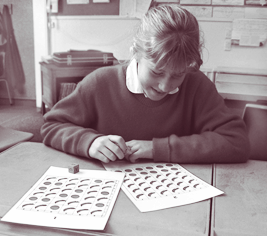 Approach: One
to one Approach: One
to one |
 Resources:
Two charts: each with 12 oranges and
24 bananas, but arranged differently; Resources:
Two charts: each with 12 oranges and
24 bananas, but arranged differently;
2 dice: one numbered 1-6, one labelled A - F. |
|
 Questions
/ instructions: Questions
/ instructions:
Show chart 1 and 2 dice.
A monkey gets his lunch by throwing these two dice, then the zookeeper gives him
the lunch shown on the chart.
|
| |
%
responses |
|
y4
|
y8
|
|
1.Do you think that the monkey has
more chance of getting an orange or a banana for lunch?
Tell me why you think that.
|
banana
|
94
|
98
|
|
more
bananas than oranges on chart
|
64
|
92
|
|
You can see letters along the top
of the chart, and numbers down the side. To find out what monkey gets for lunch,
we throw the dice. One tells the letter, and the other tells the number. We'll
have a practice go by throwing the dice and seeing what monkey would get.
Student has one practice throw and locates the appropriate lunch item on the
chart. If the student has difficulty locating the fruit, give guidance. Hand student
the recording book open at the weekly menu plan.
Now I want you to throw the dice for each day of the week — and write down
an "o" for orange, or "b" for banana on this sheet, to show
what food monkey gets each day.
When the student has completed
the 7 throws...
|
|
|
|
2. Now that you've tried choosing
lunches for one week, do you think that the monkey has more chance of getting
an orange or a banana for lunch?
Tell me why you think that.
|
banana
|
83
|
83
|
|
referred
to chart (population)
|
28
|
37
|
|
referred
to sample favouring bananas
|
41
|
41
|
|
referred
to sample favouring oranges
|
9
|
12
|
|
Show chart 2.
3. Now look at this chart. Do you think monkey has more chance of getting
an orange or a banana for lunch?
Tell me why you think that.
|
banana
|
88
|
89
|
|
more
bananas than oranges on chart
|
74
|
85
|
4.
What are the chances of the monkey getting an orange?
Why do you think that? |
one
third (or similar)
|
3
|
40
|
|
less
than one half
|
6
|
18
|
|
other
|
91
|
42
|
|
Commentary:
Students succeeded well with the first question, although many Year 4 students
made their choice "because monkeys like bananas". Taking a sample tended
to divert students' attention from the proportions on the chart, so that many
made their judgements in question 2 on the basis of the sampling results. Very
few year 4 students could deal with the idea of probability.
|